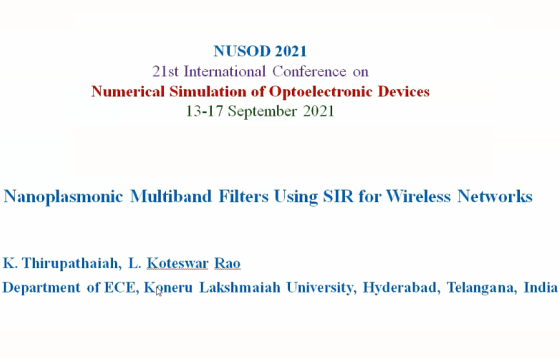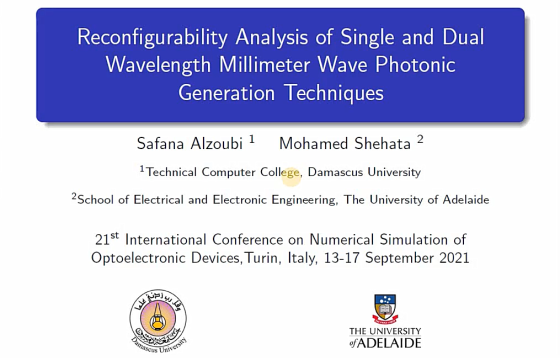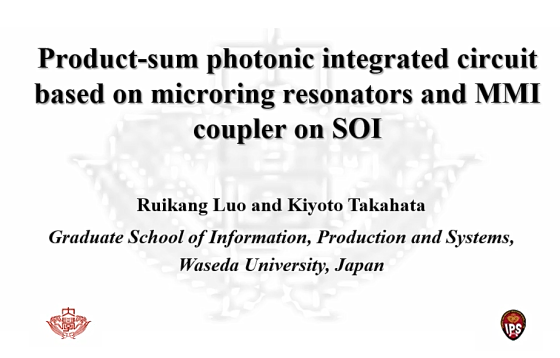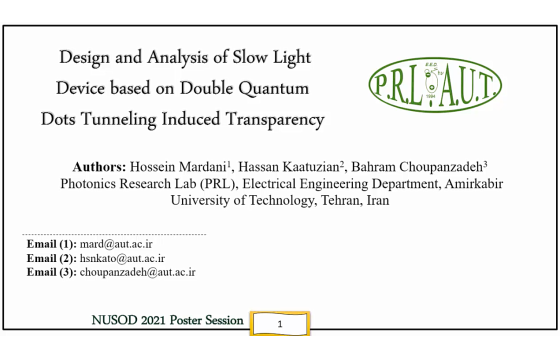Poster24 Videos



This paper presents a C-shaped optical fiber sensor for refractive index measurement. The design and simulation of the C-shaped optical fiber were conducted via Wave Optics Module-COMSOL Multiphysics®. The refractive index measurement ranging from 1.30-1.40 is performed. The simulation results showed that the C-shaped design has the potential to act as a refractive index sensor […]
N08–Dependence of conduction mechanism on bias and temperature in quantum-dot based electroluminescent devices
Quantum dots (QDs) provide some unique properties which make them preferable over other luminescent materials, one such property being adjustable and sharp emission which makes it an interesting candidate for electroluminescent devices. A QD based electroluminescent device has been taken into consideration in this theoretical study. The effect of the bias, temperature, the presence of […]
P09–Nanoplasmonic Multiband Filters Using SIR for Wireless Networks
This article demonstrates design and numerical analysis of the multiband band-pass and band-stop filters using an even-mode MIM waveguide-based step impedance resonator (SIR) and simultaneously operated at optical bands O & L bands (185.72 THz and 230.02 THz) with higher efficiency (>35 dB)
N09–Luminescence Decay Kinetics of Electron-Hole Plasma in II-VI Epitaxial Layers and Micropowders
The luminescence decay kinetics of epitaxial layers of ZnSe and micropowders of ZnSe and CdS were measured at room temperature and at high levels of optical excitation. Comparison of the experimental results with the theoretically calculated decay kinetics showed good agreement for the initial moment of time at high concentrations of nonequilibrium charge carriers.
IS09–Modeling of polarization-rotation based photonic D flip-flop using a compact micro-ring resonator
This paper demonstrates the modeling and simulation of all-optical polarization rotation based clocked D flip-flop using a single micro-ring resonator. The simulated results show the switching time of 0.5 ps and the on-off ratio of 25.27 dB.
D08–Numerical simulation on the effect of the working temperature on the response sensitivity for GaAs-based blocked impurity band (BIB) terahertz detectors
Working temperature is a critical parameter to evaluate the performance of Gallium Arsenide (GaAs) blocked impurity-band (BIB) terahertz detector. An optimal devicetemperature can ensure the best response sensitivity. Therefore, we analyze the effect of device temperature on the response sensitivity characteristics of GaAs-based BIB detector by numerical simulation. The simulated result shows that the optimal […]
IS10–Reconfigurability Analysis of Single and Dual Wavelength Millimeter Wave Photonic Generation Techniques
Optimizing the operating conditions of a Mach-Zhender modulator (MZM) for different design requirements has drawn considerable research interests due to its key role as an electro-optic (EO) interface in hybrid access radio-over-fiber networks. In this work, we compare the modulation efficiency and the bit error rate (BER) performances of single and dual-wavelength-modulated millimeter-wave (MMW) photonic […]
D09–Near Infra-red Photosensor using Optically Gated D-MOS Vertical TFET
This article reports a highly sensitive and low power photosensor using dual MOSCAP Vertical TFET for near infrared light detection in the wavelength range 0.7µm to 1µm. The optical voltage (VOP) developed because of the photogeneration occurring within the gate region enhances the gate control over the channel and produces higher drain current. The sensitivity […]
IS11–Design of all-optical Chalcogenide T-flip flop using Photonic Crystal Waveguide
The field of designing photonic crystal based all optical devices is the recent research trend as it remarkably promises an opportunity to diminish circuit complexity. The main intention of this present work is to contrive novel photonic crystal waveguide based all optical chalcogenide T-flip flop. Finally the efficient performance is numerically demonstrated to show elevated […]
SC07–Impact of effective capture cross section on generation-recombination rate in InAs/GaAs quantum dot solar cell
Quantum dot solar cell structures have been theoretically analysed to study the impact of effective capture cross sections on quantum dot generation-recombination processes. The Poisson’s and continuity equation were solved self-consistently to obtain electrostatic potential, electron and hole carrier distribution, and electron filling of the QDs. The occupation probability of the QDs was used to […]
IS08–Product-sum photonic integrated circuit based on microring resonators and MMI coupler on SOI
A product-sum photonic integrated circuit consisting of SOI-based cascaded microring modulators and a 4×1 multimode interference coupler is proposed for CNN computing. A basic product-sum operation is numerically demonstrated for 2×2 matrix.
LED04–Marked efficiency enhancement of 222 nm AlGaN-based deep-UV LEDs for disinfection of SARS-2 (Covid-19)
The AlGaN-based deep ultraviolet light emitting diodes (DUV LEDs) for the disinfection of SARS-2 (Covid-19) are proposed in this study. The optoelectronic characteristics of DUV LEDs are numerically analyzed. The results show that the internal quantum efficiency (IQE) and radiative recombination rate are excellently improved in the proposed LED. This significant enhancement is due to […]
MM07–Optimization of Two-Dimensional Photonic Crystals with Artificial Bee Colony Algorithm
We applied the Artificial Bee Colony algorithm for the complete band gap maximization of a two-dimensional photonic crystal. The band diagram and band gap calculation were carried out by the software MIT Photonic Bands, and these results were used in the algorithm’s fitness function. The optimum structure was compared to the literature which used genetic […]
LED05–Engineering the Active Region to Enhance the IQE by ~8% in AlGaN/GaN based UVC LED
To increase the internal quantum efficiency (IQE) of AlGaN/GaN based multi quantum-well (MQW) UV-C LED, the aluminium composition of barriers and wells in the active region has been engineered. Increase in electron-hole overlap and hence the radiative recombination rate in the final engineered structure has enabled to enhance the IQE by 8%.
MM08–Controlling Nonlinearities in Semiconductor Superlattice Multipliers
A hybrid approach combining Nonequilibrium Green’s Fuctions with solutions of the Boltzman equation, delivers voltage and intrinsic asymmetry control of nonlinearities in semiconductor superlattices. Unexpected nonlinear behavior is predicted for high harmonics as a result of voltage control.
LED06–Modeling of secondary optics LED aerodrome fires
The development of LED technology has allowed the Ukrainian Association of Lighting Enterprises of Vatra Corporation to develop the construction of LED equipment for the airfield light signal systems. Features of fire design, angles of installation of fires, difficulties in observing LED aerodrome fires – these factors influence the decision making when establishing visual contact. […]
IS12pd–Modelling of mid-IR on-chip Doppler FMCW LiDAR System
We propose a generic model that can simulate the functioning of doppler LiDAR system from given target speed, working distance and modulation pattern. Simulations confirm that our model yield system performance consistent with the theoretical calculations.
NM07–Design and Analysis of Slow Light Device based on Double Quantum Dots Tunneling Induced Transparency
Slow light Transparency window can be achieved with the help of Electromagnetically Induced Transparency (EIT) method and Tunneling Induced Transparency (TIT) method accompanied by observing tunneling effect between InAs quantum dot structure with energy gap of 0.35 eV and a thin layer of GaAs potential barrier with energy gap of 1.42 eV. By investigating different […]
P06–Moving Bragg Solitons in a Coupler with Separated Grating and Cubic-Quintic Nonlinearity
We investigate the existence and stability of moving solitons a semilinear directional coupler where one core has cubic-quintic nonlinearity and the other core is linear with uniform Bragg grating.
IS13pd–6‑Channel Plasmonic Demultiplexer using Metal/Insulator/Metal Based Circular Resonators with Silver Nano Rods Arrays
In this paper, we design and propose a compact 6-channel plasmonic demultiplexer (DMUX), utilizing of metal/insulator/metal (MIM) circular resonators (CRs) with metal nano‑rod arrays (NRAs). The resonance wavelengths of the output ports depend on the number of metallic NRAs in the CRs. For the numerical examination of the designed scheme, the finite‑difference time‑domain (FDTD) technique […]
N03–Numerical and Experimental Characterization of Chirped Quantum Dot-based Semiconductor Optical Amplifiers
We present a model for the description of the dynamical behavior of Quantum Dot (QD) based Semiconductor Optical Amplifiers (SOAs) under injection of optical pulses. The model uses a Time Domain Traveling Wave (TDTW) approach to describe the optical field in the amplifier, and allows us to consider chirped QD materials by the inclusion of […]
P07–Analysis of a phase shifter based on a slot polymeric waveguide with liquid crystal cladding
We numerically investigated a phase shifter based on a polymeric platform by using two different approaches. The device consists of a polymeric slot waveguide covered with an organic liquid crystal cladding, which is a promising configuration for the implementation of polymeric waveguide systems for computation, communication and sensing. Two different nematic liquid crystals have been […]
IS14pd–Real-time Thickness Measurement with a Modified Sagnac Interferometer Using Phase Shift Technique
The modified Sagnac interferometer with a phase-shift approach is given here for measuring Ta2O5 thin-film thickness. The input light is split into reference and sample beams. A real-time signal measurement is performed to get the output intensities of both beams with four different polarizer settings. These intensities can then be effectively converted into film thickness.
N07–Short Pulses from QD Laser Excited State
For the first time gain-switched short pulse generation with a width of 25-40 ps from excited state is demonstrated applying an external optical Gaussian beam to the excited state of InAs-InP-(113)B quantum dot laser.



























